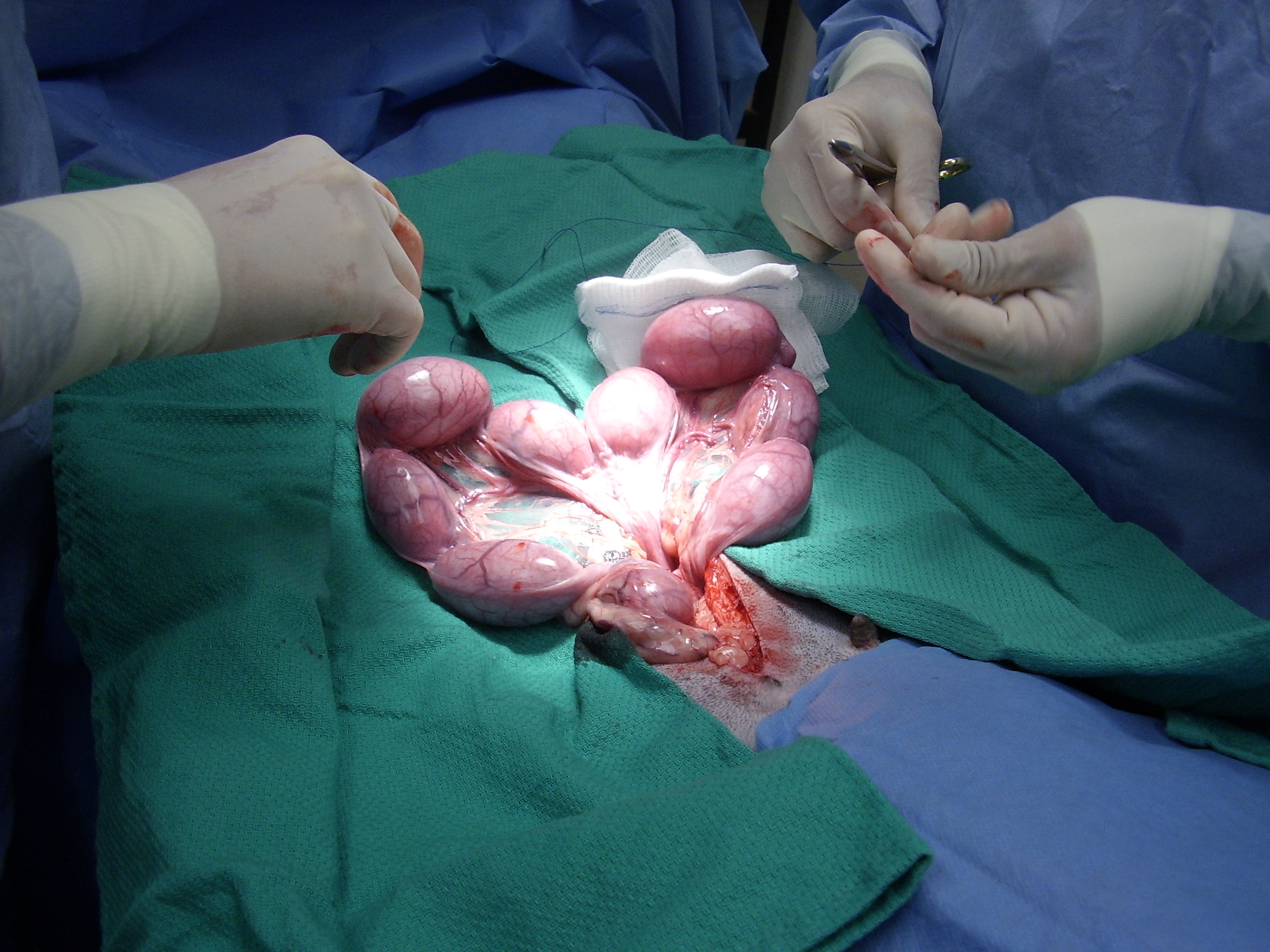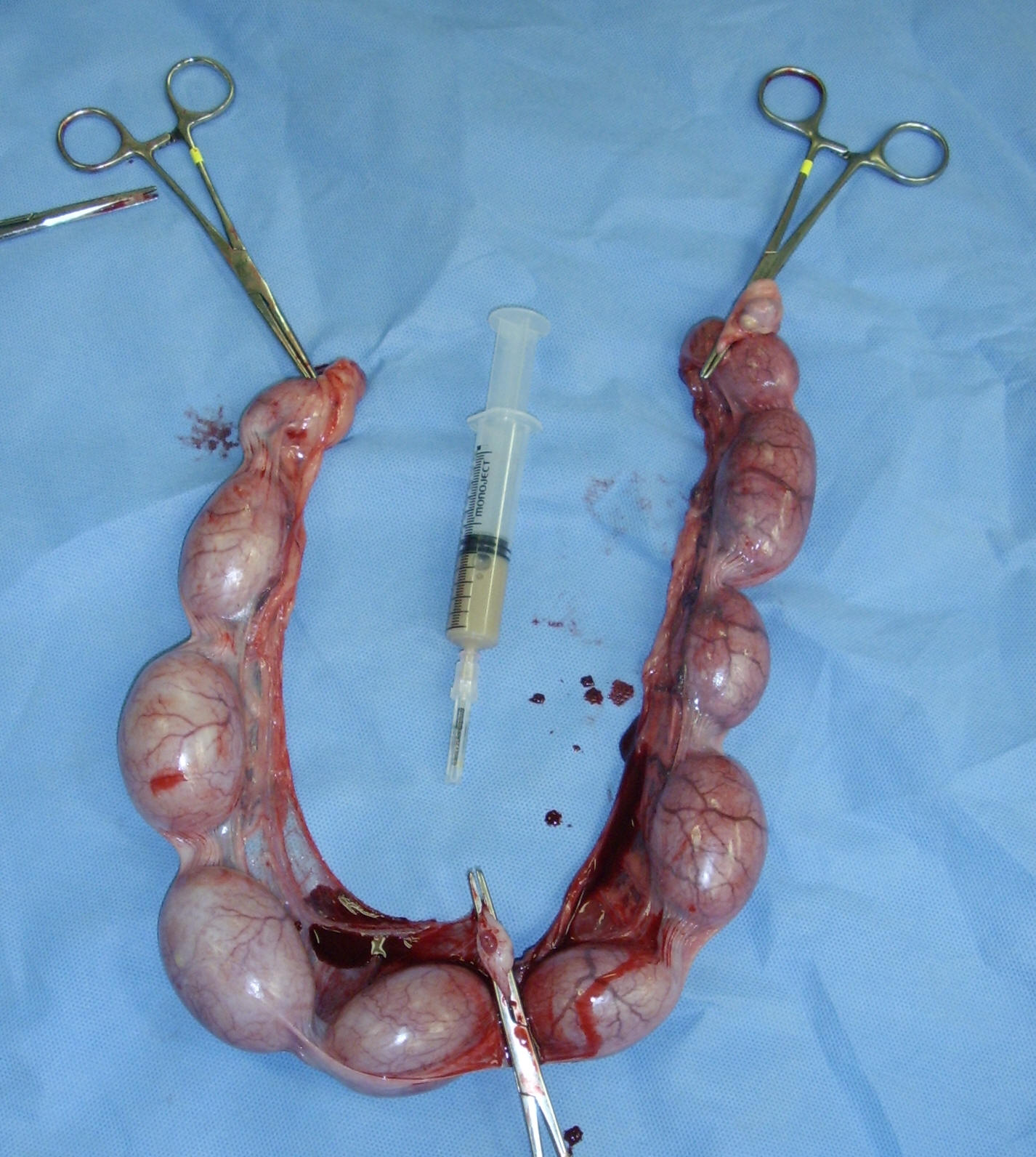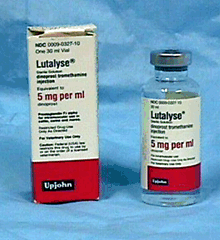| Pyometra
in the Bitch

 207-220 207-220
- Cystic Endometrial Hyperplasia (CEH) vs
Pyometra
- Two distinct entities
- CEH
- From repeated repeated progesterone exposure
(cycles)
- Glands vary in size
- Glands cystic
- Sterile fluid - mucometra or hydrometra
- Not an inflammatory condition
- Increased progesterone and estrogen receptors
- Can induce CEH with:
- Mechanical irritation
- Biopsy
- Scarification
- Silk suture
- Bacteria
- Changes reverse if progesterone removed
- Another form of endometrial hyperplasia
- As with CEH, it occurs primarily during the
luteal phase of the cycle,
- Endometrium responds to stimuli with a highly
organized proliferative remodeling (similar to the normal
histology of the endometrium at placentation sites in normal
pregnancy)
- . Although referred to as deciduoma, Schlafer
and Gifford propose the use of the term pseudo-placentational
endometrial hyperplasia to help distinguish it from CEH
- Pyometra
- Complex etiology
- Hormone
- Infectious
- Immunologic
- Hormone
- Estrogen and Progesterone not different in
pyometra vs. normal cycle
- Receptors normal (one study found reduced)
- Estrogen enhances the stimulatory effects of
progesterone on the uterus by inducing progesterone receptors.
- In
particular, pharmacological concentrations of estrogen
administered during diestrus greatly increases the risk of
pyometra.
- Recent study showed no difference when
estradiol benzoate was used for mismate.
- Bacterial
- E. coli.
- Primary
- 11-20 and 21-30 days post LH primary days of
infection
- Same as intestinal or urinary tract
- Same virulence factors
- P fimbriae - enhances tissue damage
- α-haemolysin- enhances free iron
- Cytotoxic necrotizing factor 1 -
enhances tissue damage
- Endotoxin release
- lipopolysaccharide parts of the cell wall of
gram-negative bacteria - thought to be responsible for the
systemic signs of pyometra in bitches
- Stimulates prostaglandin synthesis
(especially PGE2), which further contributes to the
suppressed activity of cellular immunity during diestrus.
- Measuring blood concentration of the
PGF2α metabolite (PGFM) also provides an indicator of
endotoxin release in bitches with pyometra, and helps in the
differentiation between pyometra and CEH
- Other bacteria
- Streptococcus spp,
- Klebsiella species,
- Staphylococcus aureus,
- Pasteurella spp,
- Proteus spp
- Pseudomonas spp
- Systemic inflammatory response syndrome
(SIRS)
- Uncontrolled production of other inflammatory
mediators
- tumor necrosis factor (TNF)
- interleukins (IL-1 and IL-6)
- platelet activating factor
- may provoke irreversible damage to
internal organs or septic shock, which can cause death
- Polyuria/polydypsia
- Multifactorial origin
- Renal tubular cell damage,
- Impaired ability of the loop of Henle to
reabsorb sodium and chloride,
- Increased tubular insensitivity to
anti-diuretic hormone (ADH)
- Loss of urinary concentrating ability.
- Not an immunomediated
glumerulonephritis.
- No glomerular damage
- Reversible after OHE and is most likely due
to endotoxin effects


Clinical signs
- May be none with uncomplicated CEH or
mucometra or hydrometra
- Usually the dogs are greater than 6 years old,
because it takes multiple progesterone exposures. This is a
diestrus disease, so estrus was probably within the last month.
- With open cervix pyometra you see a vaginal
discharge, lethargy, depression, anorexia/inappetance, polyuria/polydypsia,
and vomiting. The dogs are generally relatively healthy though. WBC
count is high or normal.
- With closed cervix pyometra you see depression,
lethargy, weakness, inappetance, polyuria/polydypsia, and
vomiting. The WBC is usually high with a left shift.

Sick

High white count
 
Polyuria/polydypsis
Diagnosis
- History
- Clinical signs
-
White blood cell count is usually high
(30,000) with a left shift.
- UA
- May reveal isosthenuria.
- Do not do cystocentisis
- BUN may be elevated.
- Ultrasound and radiographs show an enlarged,
fluid filled uterus. Ultrasound is particularly useful, as the
normal pregnant uterus will show up as an enlarged uterus on
radiographs.
Treatment
- Ovariohysterectomy
is the treatment of choice in the
non-breeding bitch.
- 5 to 8% mortality
- Systemic antibiotics for 2 weeks

Lutalyse-the
Upjohn-Pharmacia prostaglandin
- Prostaglandin plus
antibiotics (broad spectrum to get the E.
coli). If it is a closed cervix pyometra,
you should see some discharge by third day of treatment. Some
people do not like to treat a closed cervix pyometra with
prostaglandins as there is a fear of uterine rupture. There are
reports of successful treatments of closed cervix pyometras (some
died too!)
- Relaxing the cervix has been
done using Prostaglandin E (misoprostol),
applied topically once or twice daily.
- Administer Lutalyse at a dose of 0.15 mg/kg, SC,
BID or TID for 1-1½ days, then 0.25 mg/kg for 5-7 days. You may
see all the side effects of prostaglandin such as restless,
salivation, urination, vomiting, diarrhea, and cardiovascular
collapse. These side effects are reduced if you begin with a low
dose and increase the dose second day. The side effects usually
diminish as treatment progresses.
- Reevaluate in 2 weeks. If any signs are still
present, repeat the treatment.
- Prostaglandin with a
dopamine-agonist or a progesterone-receptor
antagonist
- Clinical improvement in 48
hours
- No discharge in 4-7 days
- Normal CBC in 6-15 days
- Dopamine agonists (cabergoline
5 µg/kg once a day or bromocriptine 25 µg/kg,
twice or thrice daily) with either natural or
synthetic prostaglandins.
- Potentiates the
luteolytic effects of each drug resulting in a
more rapid luteolyses
- Allows using lower PG doses
- Progesterone concentrations
decline in <24 to 48 hours,
- Cervical opening 1-2
days,
- Success rate
- 80% with the combination of
cabergoline (5 µg/kg PO) and cloprostenol (1
µg/kg SC) once a day for 7 days. Cloprostenol
administration was continued until day 14, if no
response to treatment was observed.
- 95% - cabergoline (5 µg/kg
PO) and cloprostenol (5 µg/kg) administered
every third day, during 10 days.
- Progesterone-receptor
antagonists {mifepristone (RU 486) or
aglepristone (RU 534)}
- Competitive antagonists of the
progesterone receptor - result in decreased
intra-uterine progesterone
- Prevents progesterone effects
- Causes cervical relaxation -
Aglepristone can be used as an effective means
of inducing cervical dilation in cases of closed
cervix pyometra (within 48 h)
- Should be used in combination
with prostaglandin
- Combination of aglepristone
(10 mg/kg on days 1, 2 and 8) with cloprostenol
(1µg/kg on days 3-7)
- More effective than
aglepristone alone
- Success rate at day 90 of 84%
- Clinical signs, blood
parameters and uterine diameter consistently
improved to normal values,
- Breed the bitch on the next estrus as recurrence
likely.
- Fertility (64-87%) has been reported after treatment,
however it is lower than normal.
|
 Next
Page
Next
Page Canine
Index
Canine
Index Next
Page
Next
Page Canine
Index
Canine
Index